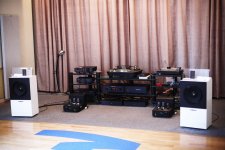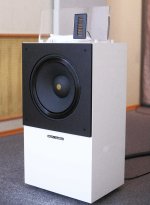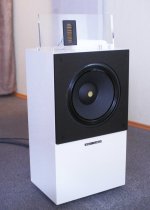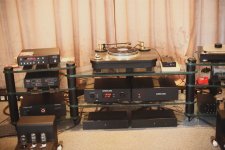- Thread Author
- #1
Heart Over Mind: Von Langa‘s Son
This time, I tested a newer Wolf von Langa model named Son. (Son is a style of music and dance, which originated in Cuba and became popular worldwide in the 1930s.) The loudspeakers were not small. The floor-standing unit was quite substantial, with each speaker weighing more than 80 pounds (40 kilograms). They have a very surprising design for modern loudspeakers. The minimal use of color is powerfully attractive, evoking the image of a white piano and a black coat.
There are 11-inch (29-centimeter) speakers with magnetization on this large audio system that has an old-school look. The speakers can easily be considered full-range. In addition, a passive radiator is placed on the back side.
The design is completed by a separate AMT tweeter in a transparent frame that is manufactured by Mundorf and perfected by Wolf von Langa. Not only is the design unorthodox, but it is also practical. It makes the orientation of tweeter output much easier. You have got to admit that it is not a common loudspeaker design.
Based on the technical characteristics – sensitivity of 96 dB/W/m – the assumption is that the speakers will do well, even with a low-power SE, not to mention more powerful amplifiers.
Moving from words to action, it is time to test the sound. Although we could go on discussing Son’s technical parameters and construction, we should remember that loudspeakers are meant for listening to music. The audio equipment merely helps convey the music to our hearts.
I brought a bunch of records with me, but it was not necessary. Tchernov Audio has an excellent collection of LP records that will not disappoint the most demanding music lover.
We started with an original 1956 Julie London record. Naturally, in mono. I almost couldn’t recognize my old, worn vinyl record; it sounded almost like it was in mint condition. A Miyajima mono cartridge worked wonders: It was as though London walked into the room and sang a couple of her greatest hits with her amazing, soulful voice. When you hear this, you understand clearly that the first degradation in audio quality is caused by stereo sound.
As you know, wind instruments are a serious test for an audio system. Bad-sounding saxophones are a common issue for the modern, high-end speakers. When it comes to saxophonists, Ben Webster and John Coltrane are so different, yet the sound of both of them playing was as close to reality as possible, causing a powerful release of endorphins among listeners.
Nina Simone’s record was prepared by the system owners, but it was exactly what was needed for a smooth transition to a stereo playback. It is difficult to put the performance of the system into words, so I urge you to listen to these two tracks in order to appreciate how it coped with the task so musically and delicately.
Possibly one the most challenging tests for an acoustic system is large symphonic compositions and concerts featuring keyboard instruments. Playback errors can destroy the fragile nature of orchestral music and ruin the piano sound.
Mozart's Piano Concerto No. 23, performed by Vladimir Horowitz – a Russian-born, American classical pianist and composer – with the Orchestra of La Scala, is a good choice for testing the system.
From the first notes, it was clear that Son is again at its best. Brilliant music, fantastic performance, and amazing playback – what else to wish for? Naturally, I knew that Horowitz was a supreme pianist before, but somehow, at this moment, his genius and mastery became so apparent to me. Check out the video and hear it for yourself.
It is common that speakers, which play the classics amazingly, cannot perform as well when it comes to rock music. The first press of Creedence Clearwater Revival, thoughtfully prepared by Tchernov Audio, proved the quality of these speakers. As the stylus slowly lowered onto the vinyl, the Moscow office instantly transformed into suburban California. I felt like a shaggy, barefooted hippie in ripped jeans. It even made me feel as skinny as when I was 19; carefree, and headed towards the bright and happy future along with my hippy companion.
At the end of the day, we listened to Alfred Brendel performing a Beethoven sonata. Alfred Brendel no longer performs, therefore we can only rely on the recordings to appreciate his incredible artistry and musicianship. Son did the job perfectly. One could experience the finest nuances of Brendel’s performance, as if it were live.
To conclude, I would like to say that, in my opinion, Wolf von Langa did what is almost impossible – Son’s acoustics managed to pull off a performance that even much more expensive systems struggle to achieve. It created a sense of complete immersion into the music, allowing the listener to travel in time and space. Suddenly, the best concert halls of the world welcome you to meet the greatest artists of the past century.
I could describe Son’s sound as deep, perfectly tuned, and of a rich timbre. The high resolution speakers allow you to hear everything present on the record.
The range of the sound is surprising for the relatively-modest size of the speakers. The sound of a symphonic orchestra shook the walls, consuming the listener with its diversity and grandeur. The speakers also perfectly convey the energetic nature of rock music. Becoming one with the music is guaranteed. In my opinion, this is the main task of audio equipment.
Are there any disadvantages with Son loudspeakers? Perhaps there are. Experts, with the help of professional equipment, could probably identify them. However, most audiophiles will definitely appreciate the incredible musicality of Son acoustic system, as well as the long-lasting communion with masterpieces of musical culture it represents.
Characteristics:
Frequency response: 25 - 30,000 Hz.
Sensitivity: 96 dB / W / m
Impedance: 8 ohms nominal, minimum of 4 ohms.
Dimensions: 404 x 874 x 330 mm
Weight: 42 kg
Company Website: WolfvonLanga.com
Heads: Miyajima Laboratory Zero (mono), Dynavector DRT XV-1t (stereo)
Tonearms: Schroeder Referenz SQ, Schroeder CB164 (282 mm)
Turntable: improved turntable on the basis of Garrard 501 (shale plinth)
Step-up MC amplifier: Tchernov AudioBlack Box-1
The tube phono stage: Tchernov AudioBlack Box-2
Pre-amplifier: an experimental model by Tchernov Audio
Power Amplifiers: pre-production samples monoblock byTchernov Audio
Speakers: Wolf von Langa Son
Cables: power cables Tchernov Cable Reference AC Power, interconnects Ultimate IC, speaker cables Ultimate SC.
Here is my new review of Wolf von Langa speakers.
Original Russian version:
http://mag.soundex.ru/october2016/6/




